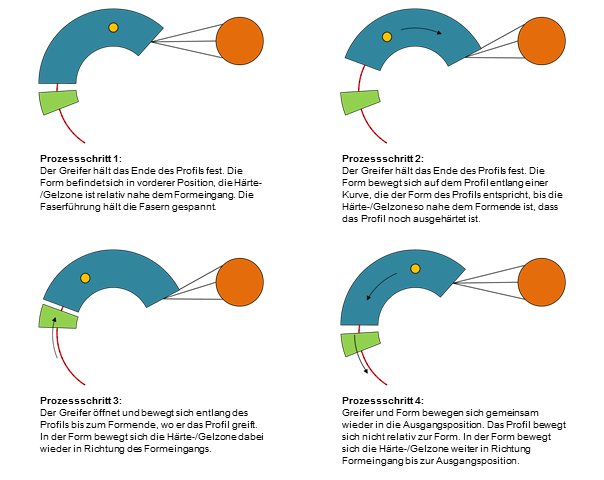Moving mold pultrusion
The moving-mold Pultrusion is a continuous production process for the production of fiber-reinforced plastic profiles, which in contrast to the pultrusion manufacturing curved profiles allowed with a stationary form, but also avoids many other disadvantages of the "classic" pultrusion. It was initially developed specifically for the production of curved profiles and is therefore also known as "Radius Pultrusion" .
history
Moving Mold Pultrusion was developed in 2008 by Thomas GmbH + Co. Technik + Innovation KG in Bremervörde in order to solve the problem of manufacturing curved fiber composite profiles in large series. In the first version, only two-dimensional curved profiles with a constant radius could be produced. It was against this background that the term "radius pultrusion" was created.
In 2009, the process was extended to three-dimensionally curved profiles (including helical profiles). Since then, all profiles can be produced that can be displayed as a superposition of constant radii.
In the course of the development it was shown that the principle of the moving mold has the potential to significantly reduce or solve many fundamental problems of the conventional pultrusion process. For this reason the designation was changed from "Radius-Pultrusion" to "Moving-Mold-Pultrusion".
Procedure
While in the conventional pultrusion process, due to the process sequence in which the profile is drawn through a stationary mold, only straight profiles can be produced, this problem is solved by reversing the process.
In contrast to the conventional pultrusion process, in this process the mold, the cavity of which corresponds to the curvature of the desired profile, is moved gradually along the curved profile. In order to describe the process more precisely, it is necessary to clearly define the direction of movement of the shape. If the movement of the shape in the direction of the fibers is defined as a forward movement and in the direction of the resulting profile as a backward movement, the process can be described as follows:
If the mold moves "forwards" in this sense, a gripper that is simply present in this process holds the profile that has already been produced directly behind the mold. The cured profile thus emerges from the mold, while the front end of the mold picks up the impregnated, not yet cured fibers. If the mold moves backwards, the profile within the mold will not move and the mold will pull new fibers out of the fiber shelf. Depending on how well the fibers "stick" in the mold, it is necessary to move the gripper as well and use it for pulling it out. This situation is shown in the figure in process steps 1–4.
The decisive difference to the conventional pultrusion process is that the movement of the inlet opening of the mold corresponds to the later course of the fibers in the profile, so that the fibers are brought into the position and length in the later profile even in the uncured state. Of course, this also applies along the entire curing process. This new technology thus enables sophisticated layer structures to be realized even in linear processes.
When it comes to the process speed, the same boundary conditions apply to moving mold pultrusion as to conventional pultrusion, i.e. H. the process speed is determined by the rate of polymerisation of the resin and the length of the mold. For the design of a machine, this means that because of the step method, the maximum speeds are at least twice the process speed.
outlook
In principle, it is also possible with modifications to the moving mold pultrusion, e.g. B. to depict endless tubes with large wall thicknesses or profiles with variable radii. These modifications of the process are the subject of current and future developments.


